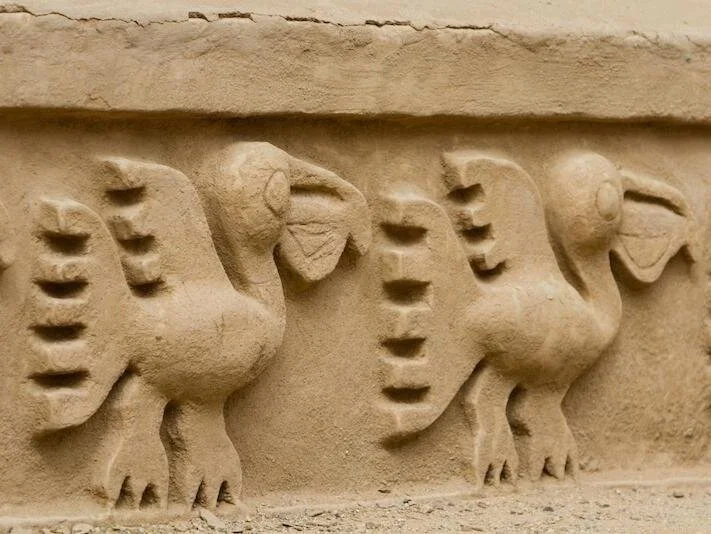Learn about the chimu - a pre-Inca Civilisation
The Chimu culture (also known as the Kingdom of Chimor) emerged on Peru’s northern coast during what is known as the Imperial Era, from 850 AD until conquered by the Inca Empire around 1470. They, along with the Sican culture, were the successors to the Moche in the region.
Chimu wooden idol discovered at Chan Chan.
The Chimu built their vast capital at Chan Chan in the Moche River valley, and gradually increased their influence by conquest.
At its zenith from around 1350, having defeated the neighbouring Sican, the Chimu state covered some 1,000 km (621 miles) of coastal desert, from the fortress of Paramonga in Lima province to the South, to modern-day Tumbes in the North.
But having resisted the expanse of Inca dominion, the Chimu leaders finally surrendered to the forces of Tupac Inca Yupanqui, after they managed to cut off the water supply to Chan Chan.
Chimu Economy:
The Chimu were highly competent hydraulic engineers, which was essential to irrigate the desert sufficiently to sustain agriculture.
Crops raised included beans, sweet potato, papaya, and cotton. Evidence of the keeping of llamas as a source of meat has also been uncovered.
The Chimu diet was augmented by seafood, caught in the rich fishing waters of the Pacific Ocean.
Another marine resource, the mollusk shell (Spondylus), also played a key economic and political role. It had its practical use in the manufacture of ornaments, tools, and jewellery; but perhaps more important was its symbolism, as a mark of wealth and status, and therefore a highly-tradable commodity.
The most highly-prized species, Spondylus princeps, was only to be found in the warm waters of what is now Ecuador, and required divers to go as deep as 50 m (164 ft) to prise it off underwater rocks.
Seabirds depicted on the walls of Chan Chan citadel.
To create high-status items, the Chimu had a class of artisans, who were housed in their thousands in citadels such as Chan Chan.
Chimu Ceramics:
Archaeologists have discovered two types of Chimu ceramics: unembellished pottery for everyday use; and ornate pieces for ceremonial purposes. Techniques and design showed a great deal of Moche influence:
Moulds were used
Vessels were often made up of smaller components.
Their ceramics have a characteristic dark colour as a result of being fired in ovens with a low level of oxygen.
Designs on the ceremonial pieces include depictions of animals, fruit, human & mythical characters.
Chimu ceramics at the Max Uhle Regional Museum of Casma.
Chimu Textiles:
The fabric used by the Chimu was spun from cotton and the wool of camelids, such as alpaca, vicuña and llama.
This fabric was then often coloured, using dyes created from plants such as walnut; minerals, such as clay; and insects such as cochineal.
Once woven, the garments were decorated with embroidery, feathers and jewellery.
Chimu Metallurgy:
Using copper, arsenical bronze, silver and gold, Chimu metalsmiths were able to make goblets, plates and jewellery, for the use of the aristocracy.
Their work shows a high level of metallurgical proficiency: soldering, casting, coating, stamping and chasing were all involved in the production and decoration process.
Examples of Chimu crowns and body adornments made of silver, at Larco Herrera Museum
How to enjoy the vestiges of Chimu Culture with PeruNorth:
Chan Chan: As a major archaeological highlight of not just Peru, but the whole of South America, all PeruNorth itineraries that go to Trujillo, not surprisingly, include a visit Chan Chan:
Some of the above itineraries also include a visit to Huaca Arco Iris (also known as Huaca Dragon), another Chimu site.
Museums:
The Max Uhle Regional Museum of Casma is to be found within the grounds of Sechin, and contains Chimu, Chavin and Wari ceramics.
Further north, Lambayeque’s Brüning Museum contains a number of Chimu artefacts, along with those from Moche and Sican cultures. A visit here can easily be arranged from Chiclayo.
If you can’t make it to Peru’s north coast, many beautiful pieces of Chimu ceramics, textiles and jewellery can be found in museums in Lima:
National Museum of the Archaeology, Anthropology & History of Peru
Larco Herrera Archaeological Museum
Museum of the Nation
Gold Museum





